Cell Recognition & The Immune System
1/34
There's no tags or description
Looks like no tags are added yet.
Name | Mastery | Learn | Test | Matching | Spaced |
|---|
No study sessions yet.
35 Terms
how do bacteria damage body cells
produce toxins
how do viruses damage body cells
use host cells to replicate before bursting out and destroying cells
how do protists damage body cells
take over cells and break them open
how do fungi damage body cells
digest living cells to destroy them and produce some toxins
what are the differences between specific and non specific defence systems
non-specific are quick and respond in the same way for all pathogens - eg. physical barriers
specific are slower but produce a specific response for each pathogen - eg. cellular response
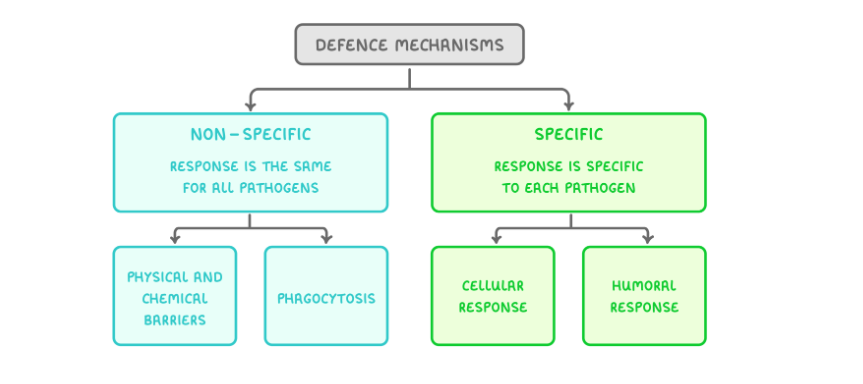
what are antigens
unique molecules (usually proteins) found on the surface of cells
these allow the immune system to be able to distinguish between body cells and foreign cells
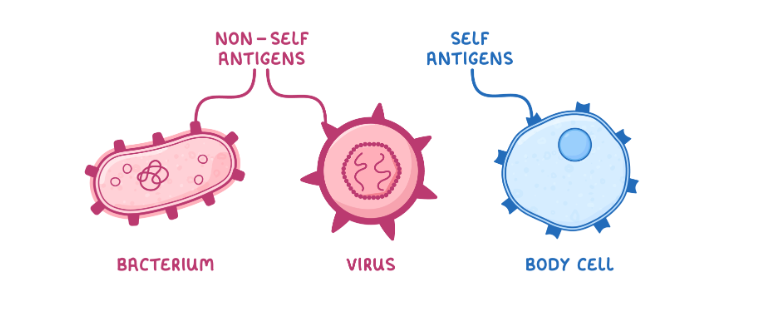
what are 4 cells and molecules that the immune system can recognise with antigens
pathogens
abnormal body cells (cancer)
toxins
cells from other organisms (eg. an organ transplant)
is phagocytosis specific or non-specific
non-specific
describe the process of phagocytosis
the pathogen releases a chemical that attracts a phagocyte
the phagocyte recognises the pathogens antigens as non-self, this causes the phagocyte to bind to the pathogen
the phagocyte engulfs the pathogen, it is now contained within a vesicle called a phagosome
the lysosome, which contains hydrolytic enzymes known has lysozymes, fuses with the phagosome - forming a phagolysosome
lysozymes digest and destroy the pathogen
the phagocyte presents the pathogen’s antigens on its surface to activate other cells in the immune system, the phagocyte is now referred to as an antigen presenting cell (APC)
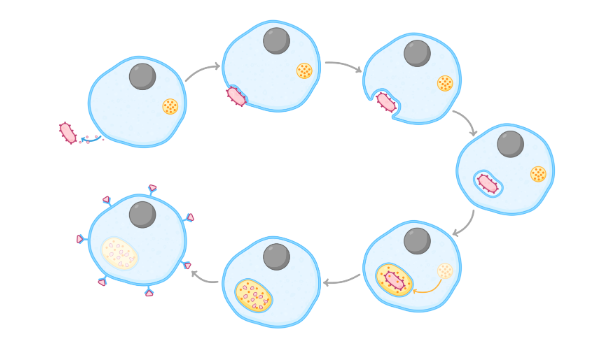
what are T cells
lymphocytes that mature in the thymus
they are involved in cellular response, where they respond to antigens presented on body cells
what are B cells
lymphocytes that mature in the bone marrow
they are involved in humoral response where they produce antibodies found in body fluids
what do helper T cells (TH ) do
they have receptors on their cell surface that bind to complimentary antigens on antigen presenting cells
after binding they can form memory cells, stimulate B cells or phagocytes and activate cytotoxic T cells (Tc)
what do cytotoxic T cells (Tc) do
the kill abnormal and foreign cells by producing a protein known as perforin
this protein makes a hole in the cell surface membrane, causing it to become freely permeable and leading to cell death
what are memory T cells
cells which provide long term immunity against specific pathogens
they provide a rapid response if the body is infected by the same pathogen
what are the stages of cellular response
phagocytes engulf pathogens and display their antigens on the cell surface, they are now known as antigen-presenting cells
helper T cells with complementary receptors binds to these antigens
on binding, the helper T cell is activated to divide by mitosis to form identical clones
what can clones T cells do
develop into memory cells - giving long term immunity
stimulate phagocytosis
stimulate division of B cells which produce antibodies
activates cytotoxic T cells, which kill infected cells
what is humoral response
production of specific antibodies to destroy pathogens
how are B cells involved with humoral response
B cells have antibodies on their cell surface membrane that bind to complementary antigens
on doing so, they engulf the antigens and display them on their cell-surface to being APCs
once activated, B cells can divide into plasma and memory cells
how are plasma cells involved in humoral response
these are types of B cells which produce and secrete antibodies against a specific antigen
they only live a few days
how are memory cells involved in humoral response
these are types of B cells that provide long-term immunity against specific pathogens
they have a much longer lifespan than plasma cells
they rapidly divide into plasma cells if the body is re-infected by the same pathogen
how are helper T cells involved in humoral response
they bind to APCs to activate the division of B cells
what are the stages of humoral response
a B cell with a complementary antibody binds to the antigens on a pathogen
the B cell engulfs the pathogen and presents its antigens on the cell-surface to become an APC
clonal selection - activated TH cells bind to the B cell, causing activation of the B cell
clonal expansion - the activated B cell divides by mitosis to form plasma and memory cell clones
the clones plasma cells produce and secrete the specific antibody which is complimentary to the antigen on the pathogen’s surface, these antibodies attach to antigens on pathogens and destroy them
the memory cells circulate the blood and tissue fluid, ready to divide if the same pathogen is detected
what is clonal selection
the B cell with the correct antibody is selected for cloning by being activated by a helper T cell
what is clonal expansion
the division of specific B cells to produce genetically identical clones
what are the differences between primary and secondary immune response for:
symptoms
cells activated
number of antibodies produced
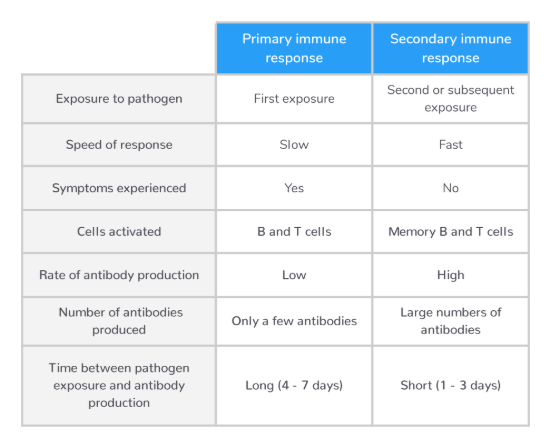
what is the structure of antibodies
Y-shaped glycoproteins
4 polypeptide chains - 2 light and 2 heavy
the polypeptide chains are held together via disulphide bridges
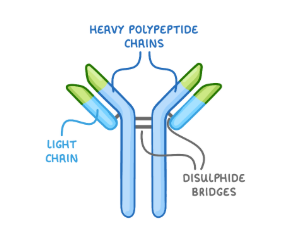
what are the 2 regions on antibodies
constant region - the same for all antibodies and binds to receptors on cells such as B cells
variable region - this is different for each antibody as its shape is complimentary to a specific antigen, this region binds to antigens
what 3 ways do antibodies help destroy pathogens
agglutination - clumping allows easier phagocytosis
neutralisation of toxins - antibodies bind to toxins, inactivating them
prevent pathogens from binding and infecting body cells
how do antibodies prevent pathogens from binding to body cells
when antibodies bind to a pathogen’s antigens, they block cell-surface receptors needed to bind to host cells
this means that the pathogen cannot bind to or invade host cells